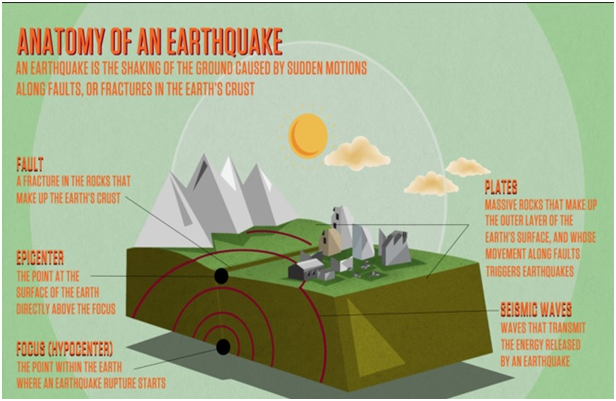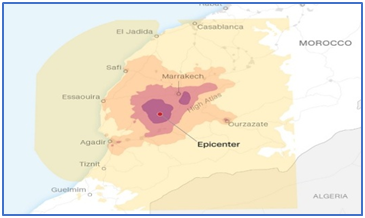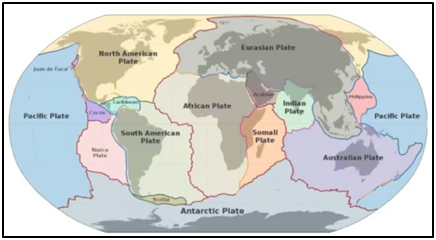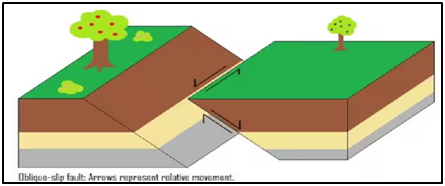Why in news?
- A rare, powerful earthquake struck Morocco on September 8 night, killing hundreds of people and damaging buildings, including in the historic city of Marrakech.
- Marrakech is a UNESCO World Heritage Site.
- So far, more than 2000 people have died, mostly in Marrakech and five provinces near the quake’s epicentre.
What’s in today’s article?
What is an Earthquake?

- An earthquake is an intense shaking of the ground caused by movement under the earth’s surface.
- The location below the earth’s surface where the earthquake starts is called the
- The location directly above the hypocentre on the surface of the earth is called the epicentre.
- It happens when two blocks (tectonic plates) of the earth suddenly slip past one another releasing stored-up ‘elastic strain’ energy in the form of seismic waves.
- These spread through the earth and cause the shaking of the ground.
- They are measured on scales called the -
- Moment Magnitude Scale (Mw), based on the total moment (a product of the distance a fault moved and the force required to move it) release of the earthquake.
- The Richter scale (magnitude scale) - energy released - 0-10.
- The intensity scale/Mercalli scale - visible damage - 1-12.
- Earthquakes continue to remain the most common natural hazard that cannot be predicted as no early warning systems can be developed.
News Summary: Earthquake in Morocco

- The epicentre of the earthquake was located in the High Atlas Mountain range, about 72 kilometers from Marrakech.
- The quake had a magnitude of 6.8, meaning it is classed as “strong.” It also struck at a relatively shallow depth, making it more destructive.
- As per the US Geological Survey (USGS),the focus was 18.5 km below the Earth’s surface, though Morocco’s own seismic agency pegged the depth at 11 km.
- Either way, it was a fairly shallow quake.
- Such quakes are generally more dangerous as they carry more energy to the surface, when compared to quakes that occur deeper underneath the surface.
- While deeper quakes do indeed spread farther as seismic waves move radially upwards to the surface, they lose energy while travelling greater distances.
- Earthquakes of this size in the region are uncommon, according to the US Geological Survey, but not unexpected.
- Nine quakes with a magnitude of 5 or higher have hit the area since 1900, but none of them have had a magnitude higher than 6.
Why the Morocco quake occurred?
- Background

- While seismicity rates are indeed lower in the region, making earthquakes rarer, they are not completely unheard of.
- According to the USGS, large destructive earthquakes have been recorded and reported from Morocco in the western Mediterranean.
- Such quakes occur due to the northward convergence of the African plate with respect to the Eurasian plate along a complex plate boundary.
- Reasons behind Morocco quake
- With respect to Morocco’s quake, the USGS attributed it to oblique-reverse faulting at shallow depth within the Moroccan High Atlas Mountain range.
What is oblique-reverse faulting?
- Fault
- A fault is a fracture or zone of fractures between two blocks of rock.
- Faults allow the blocks to move relative to each other, causing earthquakes if the movement occurs rapidly.
- During a quake, the rock on one side of the fault suddenly slips with respect to the other.
- Different types of faults
- Scientists use the angle of the fault with respect to the surface (known as the dip) and the direction of the slip along the fault to classify faults.
- Faults which move along the direction of the dip plane are dip-slip faults, whereas faults which move horizontally are known as strike-slip faults.
- Oblique-slip faults show characteristics of both dip-slip and strike-slip faults.
- The term reverse refers to a situation that the upper block, above the fault plane, moves up and over the lower block.

- Oblique-reverse faulting
- It is also known as oblique-thrust faulting.
- It is a type of geological faulting in which rocks on one side of the fault plane move vertically and horizontally in response to compressional forces.
- This type of faulting is common in areas of compression — when one tectonic plate is converging into another.













